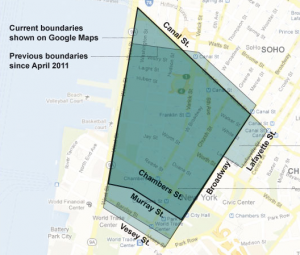In the News: Remapping Tribeca
••• “Model Karolina Kurkova is back in town, renting a three-bedroom apartment at the River Lofts [….] Kurkova and hubby Archie Drury own a unit in the posh building at 92 Laight St., though they now live in LA and rent out their NYC home. But Kurkova loves the building so much that she rented a 2,500-square-foot apartment there.” According to the headline, it’s $17,000 a month. Watch her warm up here. —New York Post
••• “The $7.7 billion that the Port Authority of New York and New Jersey has committed over more than a decade to remake the 16-acre [World Trade Center] site has meant that long-planned repairs and expansions at its other properties, especially at the area’s three major airports, have been put on hold or scrapped altogether.” —Wall Street Journal
 ••• The New York Times looks at how neighborhoods get mapped online, holding up Tribeca as an example: “Tribeca keeps creeping eastward, from the traditional Broadway to Lafayette or Centre Street. ‘That’s real estate people doing that kind of thing,’ said Mr. Hyland [a chef who lives in downtown Brooklyn], who rejects those proposed changes. ‘They want to sell a loft in Tribeca instead of a loft in Chinatown.'” Not necessarily. In my opinion, the new Google definition should include the blocks east of Broadway between Canal and Worth and extend down to the World Trade Center—and I ain’t selling nothing but ads, baby. And T-shirts!
••• The New York Times looks at how neighborhoods get mapped online, holding up Tribeca as an example: “Tribeca keeps creeping eastward, from the traditional Broadway to Lafayette or Centre Street. ‘That’s real estate people doing that kind of thing,’ said Mr. Hyland [a chef who lives in downtown Brooklyn], who rejects those proposed changes. ‘They want to sell a loft in Tribeca instead of a loft in Chinatown.'” Not necessarily. In my opinion, the new Google definition should include the blocks east of Broadway between Canal and Worth and extend down to the World Trade Center—and I ain’t selling nothing but ads, baby. And T-shirts!
••• “Dozens of types of cancer will officially join list of illnesses covered by the $4.3 billion Zadroga Act, in a final rule change that the National Institute for Occupational Safety and Health (NIOSH) plans to unveil Monday afternoon or Tuesday morning, officials said. The federal rule change will allow sick rescue and recovery workers to receive compensation for their cancer treatment as well as pain and suffering for the first time in the 11 years since the [9/11] attacks.” —DNAinfo














How real estate folk describe things is fine but meaningless. It’s how the schools are zoned that really matters…
Well, at least they have decided that the current Civic Center starts on the east side of Broadway. That’s an area not to be in – per sq. ft. Is too low
Too low for what? To make zillions of dollars when you flip a place after a couple of years?
The boundaries of Tribeca are only a matter of opinion for those who are trying to make a buck of the name “Tribeca”, including this blog.
I have lived on the east side of Broadway for almost 29 years and have always considered myself to be in Tribeca. My kids grew up playing in Washington Market Park and all started out at PS 234. This side of the ‘hood has to head west as there are no grocery stores and few amenities like gyms or restaurants east of Church Street. Years ago I had major arguments with the then school chancellor about the boundaries for PS 234. the dividing line was down the middle of B’way and the east side of the street was zoned for one of the chinatown schools. I/we won but that is all a moot point with the new zoning. At this point, Tribeca has few options other than heading East towards Lafayette and Centre as that’s where the only unrenovated housing stock is. Neighborhoods change and their boundaries change, whether the brokers are pushing it or the desires of the families wanting to be in the area are. Either way, I have truly enjoyed raising my children here and living here — hopefully retiring here!
I just actually read the article and would add that some of the comments were less than informed. To call Broadway “chinatown” is completely inaccurate. Chinatown, in fact, has worked on creeping west and north at the same time Tribeca has crept east, probably a healthy competition. While Canal and Broadway is all Asian retailers catering to the tourists looking for fake handbags there is not an overwhelming concentration of Asian families in the residential buildings between Canal and Worth Street. Again, while the building owners are pressuring to get rid of their AIR designated renters (so they can luxury condo-ize their property), many of the buildings still have artists as well as people who just wanted to live down here since the late seventies and early eighties and few of those residents own their spaces. Traditionally, the western “border” of Chinatown was the series of Court Buildings and the holding tank that run west of Baxter between White and Worth Streets. Historians can correct me, but I believe Chinatown was originally defined by tenement housing and Tribeca was the conversion of industrial space, which other than the Court complex does extend over to Centre and in some cases Baxter.